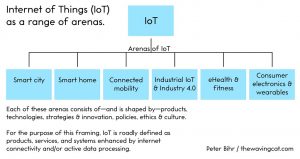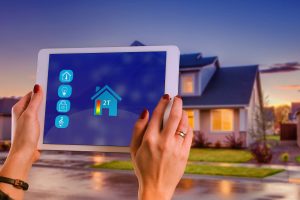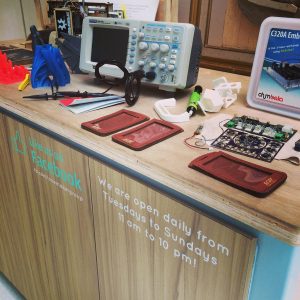Internet of things (IoT) is a system of interrelated computing devices, objects, animals or people that are provided with unique identifiers and the ability to transfer data over a network without requiring human-to-human or human-to-computer interaction.

Image source: https://search.creativecommons.org/photos/6a14b21b-58b5-49d3-80b3-000da1f88736 by Marcus John Henry Brown
The Internet of Things, or IoT, refers to the billions of physical devices around the world that are now connected to the internet, collecting and sharing data. Thanks to cheap processors and wireless networks, it’s possible to turn anything, from a pill to an aeroplane to a self-driving car into part of the IoT. This adds a level of digital intelligence to devices that would be otherwise dumb, enabling them to communicate real-time data without a human being involved, effectively merging the digital and physical worlds.
What’s the IoT?
In the broadest sense, the term IoT encompasses everything connected to the internet, but it is increasingly being used to define objects that “talk” to each other. “Simply, the Internet of Things is made up of devices – from simple sensors to smartphones and wearables – connected together,” Matthew Evans, the IoT programme head at techUK, says. By combining these connected devices with automated systems, it is possible to “gather information, analyse it and create an action” to help someone with a particular task, or learn from a process. In reality, this ranges from smart mirrors to beacons in shops and beyond.

Image source: https://search.creativecommons.org/photos/825aeb57-67ce-4c7b-9412-a6ba8e566bb4 by ITU Pictures
How it works
An IoT ecosystem consists of web-enabled smart devices that use embedded processors, sensors and communication hardware to collect, send and act on data they acquire from their environments. IoT devices share the sensor data they collect by connecting to an IoT gateway or other edge device where data is either sent to the cloud to be analyzed or analyzed locally. Sometimes, these devices communicate with other related devices and act on the information they get from one another. The devices do most of the work without human intervention, although people can interact with the devices.

Image source: https://search.creativecommons.org/photos/72bb2318-0484-4115-aea4-4bfb8ea009fe by the waving cat
Smart home
Smart Home is the term commonly used to define a residence that has appliances, lighting, heating, air conditioning, TVs, computers, entertainment audio & video systems, security, and camera systems capable of communicating with one another and can be controlled remotely by a time schedule, from any room in the home, as well as remotely from any location in the world by phone or internet.

Image source: https://pixabay.com/it/photos/smart-home-casa-tecnologia-3920905/
From just being able to call and text, smartphones allowed us to connect to the Internet. You can think of a smart home in a similar way. What sets a smart home apart from other homes is that the appliances and devices throughout the house are connected and controlled from a central device. Most homes do not have these appliances and systems built into them, therefore the most common and affordable approach is for the home owner to retrofit smart products into their own finished home. Most products are available in one of four protocols (the means of communication between themselves) and all of these are compatible with the internet, phone, and cell phones.
Pros and cons of IoT
Some of the advantages of IoT include:
- Ability to access information from anywhere at any time on any device;
- Improved communication between connected electronic devices;
- Transferring data packets over a connected network saves time and money;
- Automating tasks helps improve the quality of a business’ services and reduces the need for human intervention.
Some disadvantages of IoT include:
- As the number of connected devices increases and more information is shared between devices, the potential that a hacker could steal confidential information also increases;
- Enterprises may eventually have to deal with massive numbers – maybe even millions – of IoT devices and collecting and managing the data from all those devices will be challenging.
- If there’s a bug in the system, it’s likely that every connected device will become corrupted;
- Since there’s no international standard of compatibility for IoT, it’s difficult for devices from different manufacturers to communicate with each other.

Image source: https://search.creativecommons.org/photos/8f7699c7-95be-412a-baae-d6a7b4bb6758 by devsteve
Info source: https://www.wired.co.uk/article/
https://en.wikipedia.org/wiki/Internet_of_things
